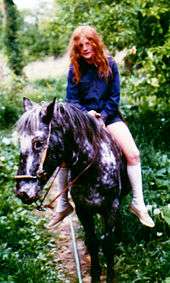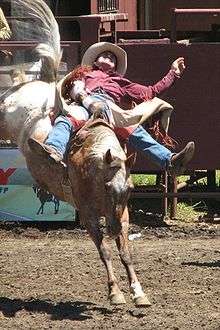Bareback riding
Bareback riding is a form of horseback riding without a saddle. It requires skill, balance, and coordination, as the rider does not have any equipment to compensate for errors of balance or skill.
Proponents of bareback riding argue that riding in this fashion is natural, allows considerable communication with the horse, and improves a rider's balance. The drawbacks include a higher risk of injury due to an increased risk of falling off the horse, the potential to develop poor riding form, and the possibility of considerable discomfort to both horse and rider due to the absence of a supporting tree and any padding between the rider's seat bones and the horse's spine. Over time, it is more fatiguing to both horse and rider to ride bareback.
However, in certain situations, bareback riding is particularly suitable. Many riders will ride bareback for a short ride in order to save time in a busy day. It is also common for a rider who will take a horse in only one direction and walk back on foot, such as when moving the horse from one pasture to another, to ride the horse in only a bridle in order to not carry much equipment when returning. In other cases, for example, if a horse is to be allowed to swim in a river, lake or ocean, it is practical to leave expensive leather horse tack off to avoid equipment damage. It is also common for riders in extreme cold weather to ride bareback for short pleasure rides in situations where heavy winter clothing makes it hazardous to ride with a saddle due to the difficulty of sitting correctly in a saddle while wearing thick insulated clothing or the potential of a large snow boot hanging in a stirrup.
Rider position

When riding bareback, riders sit a bit more forward on the horse than they would in a saddle. They have to rest their legs more forward, along the crease between the barrel and the shoulder muscles in order to have a secure position without excessive gripping. As a rule, to make proper use of the rider's calf muscles, bareback riders need to keep their heels lower than their toes, riding with a flexed ankle and heel down, just as if they had stirrups.[1][2] Riding with the toes down can lead to clutching at the horse with the lower legs or digging into the horse's sides with the heels, both often interpreted by the horse as a leg cue to go faster.[3]
It is particularly important that riders do not squeeze their heels or lower legs into the horse's sides when slowing or stopping, or use the reins as a brace at any time, as these errors will send the horse confusing, contradictory signals. If riders lose their balance, it is common to grab the mane in order to prevent jerking the horse in the mouth with the reins of the bridle, though ideally a rider can maintain proper balance by correct placement and use of their thigh and upper calf muscles.
Though some people begin riding bareback before they learn with a saddle, it is usually recommended to first learn in a saddle without stirrups, as the rider is still helped in obtaining correct position by the pommel and cantle, but is not able to use the stirrups as a crutch for poor balance or position. It is also easier on the horse's back to have the support of a saddle to cushion the action of an unbalanced rider.
Bareback pads
A bareback pad can be used to make bareback riding more comfortable for both horse and rider. The pad may also be used to help keep the rider's clothes clean. Bareback pads are often shaped like English saddle pads and are available in many colors and fabrics, most commonly felt, wool, or synthetic material.[4] They are attached with girths. Some have stirrups, although these are associated with a higher risk of injury if a rider's foot becomes entangled in the stirrup during a fall. Pads with stirrups may also injure the horse's back due to lack of a tree.[5] Bareback pads are also popular with individuals who believe that riding bareback creates a stronger bond between horse and rider. Bareback pads cannot be used as a substitute for a saddle and they can be prone to twisting around the barrel of the horse. Some instructors believe that a novice should never be allowed to go bareback until they have mastered riding with a saddle, and that bareback pads create a false sense of security; others feel that bareback is necessary to develop a new rider's balance, and the pads assist by keeping the rider from getting as sore as they would otherwise.[6]
Rodeo

There is also bareback bronc riding in the sport of rodeo. Bareback bronc riding is one of the most physically demanding events in rodeo, with a high injury rate. Cowboys ride the bucking horse one-handed and cannot touch or hang onto anything with their free hand. They use a leather rigging that includes a handle that resembles that of a suitcase, where riders place their hand. To make the event more difficult for the rider, they are required to lean back and spur in a highly stylised manner that was never historically used in actual practice. The cowboy's spurs have to be above the point of the horse's shoulders at the first jump out of the chute and touch the horse on every jump for the full-time required for a qualifying ride. They have to stay on the horse and ride with proper technique for 8 seconds in order for the ride to be judged and scored. Once the ride is complete the rider may hold on to the rigging with both hands until reached by the pickup riders, who assist the rider in getting off the still-moving horse and safely on the ground. Cowboys are judged on their control and spurring technique, and the horse is judged on their power, speed, and agility. These two scores are added together to make the total, with the highest possible score being 100 points.[7]
See also
References
- ↑ "Bareback equitation" Fergus/Petroleum 4-H Horse Program. Archived October 4, 2011, at the Wayback Machine. Accessed July 14, 2008
- ↑ Webshots. "Webshots - Venice at Sunset, Italy". webshots.com. Retrieved 12 September 2015.
- ↑ Blocksdorf, Katherine. "Learn How to Ride Bareback: Ride Your Horse Without a Saddle", About.com Accessed July 14, 2008
- ↑ "Jeffers Equine, Horse Supplies, Tack, Grooming, & Health Products - Uniquely English". jeffersequine.com. Retrieved 12 September 2015.
- ↑ "No Stirrups on Bareback Pads, Please". EQUINE Ink. Retrieved 12 September 2015.
- ↑ "The Biomechanics of Riding Bareback". practicalhorsemanmag.com. Retrieved 12 September 2015.
- ↑ Ralph Clark. "Bareback Riding Basics". About.com Sports. Retrieved 12 September 2015.